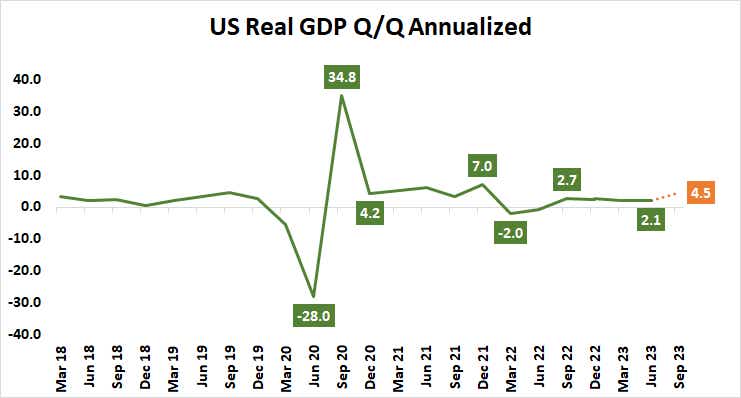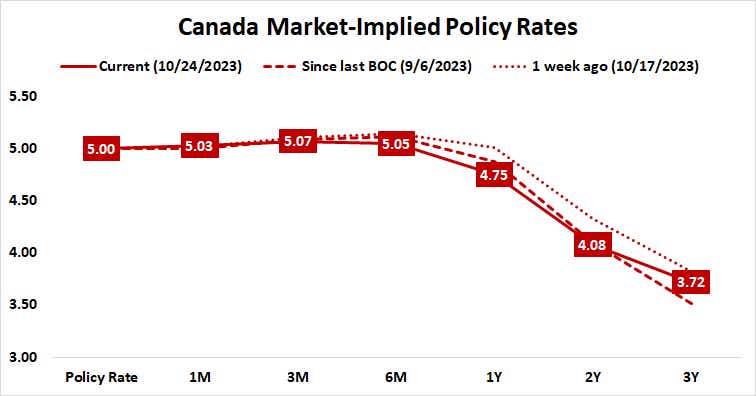Battered Stock Market May See Good News in Gloomy Economic Reports

Battered Stock Market May See Good News in Gloomy Economic Reports
By:Ilya Spivak
Underwhelming U.S. GDP data and downbeat guidance from the Bank of Canada may signal cuts in interest rates next year
- U.S. GDP growth is expected to accelerate in Q3, but the pickup may be lackluster.
- A dour economic outlook from the Bank of Canada may indicate weakening U.S. demand.
- Stock markets may cheer outcomes signaling no further delay of Fed interest rate cuts.
The Federal Reserve left markets reeling with its policy update on Sept. 20, signaling in its Summary of Economic Projections (SEP) that interest rates will be higher by about 50 basis points (bps) next year than they were thought to be in June. Stocks fell as swelling term premium pushed up longer-term Treasury yields, pointing to rising uncertainty.
Speaking last week at the Economic Club of New York, Federal Reserve Chair Jerome Powell signaled this surge in borrowing costs may have already delivered the tightening that policymakers wanted, allowing hikes to stop. The key question from here is how long the U.S. central bank intends to hold rates at the highs before a round of cuts begins.
As it stands, the markets are pricing in the arrival of the first standard-issue 25bps reduction no later than July 2024. Another leg lower is penciled in by November. The probability of a third by year-end is assessed at 84%. This week’s arrival of third-quarter U.S. gross domestic product (GDP) data as well as a monetary policy announcement from the Bank of Canada (BOC) will test how this holds up.
U.S. economic growth trends: where are we going?
The GDP report is expected to show economic growth accelerated with gusto, pushing the annualized rate to 4.5% from the 2.1% recorded in the three months up to June. Leading surveys of purchasing managers (PMI) suggest economic activity has slowed more recently, warning that the heady uptick might be too backward-looking to sway Fed officials.

Meanwhile, the BOC is expected to keep its target interest rate unchanged at 5%. As with the Fed, the markets think July’s rate increase was this cycle’s last. From here, Canada’s central bank is priced in to remain on hold for the better part of a year, with cuts starting to appear in the closing months of 2024.
Nearly 80% of Canada’s exports are bound for the U.S. What’s more, a shock GDP contraction in the second quarter was driven by slumping external demand overpowering domestic growth. That means whatever BOC officials have to say about the way forward will be potent insight into economic conditions south of the Canadian border.
The trend in the second half of 2023 points to continued weakness. Exports continued to fall in July and August compared to the prior year, while PMI data suggests the manufacturing sector—ground zero for the influence of US-driven supply chains—shrank at an accelerating pace. The third quarter may be even softer than the second.
Financial markets are pining for Fed rate cuts
Taken together, the picture painted here might prove curiously supportive for financial markets.
The jump in GDP might be underwhelming. The outcome would need to overcome economists’ already rosy expectations to alter the Fed’s calculus meaningfully, which seems unlikely. What’s more, a soggy outlook from the BOC would bolster the sense that signs of strength are stale, lagging a subsequent downturn that is already underway.

Stock markets might have hopes for the shortest possible delay before the arrival of monetary stimulus. In tandem, a pullback in bond yields may be accompanied by a retreating U.S. dollar as the window for further expansion of the currency’s yield advantage against its major peers is shuttered.
Ilya Spivak, tastylive head of global macro, has 15 years of experience in trading strategy, and he specializes in identifying thematic moves in currencies, commodities, interest rates and equities. He hosts Macro Money and co-hosts Overtime, Monday-Thursday. @Ilyaspivak
For live daily programming, market news and commentary, visit tastylive or the YouTube channels tastylive (for options traders), and tastyliveTrending for stocks, futures, forex & macro.
Trade with a better broker, open a tastytrade account today. tastylive, Inc. and tastytrade, Inc. are separate but affiliated companies.
Options involve risk and are not suitable for all investors. Please read Characteristics and Risks of Standardized Options before deciding to invest in options.